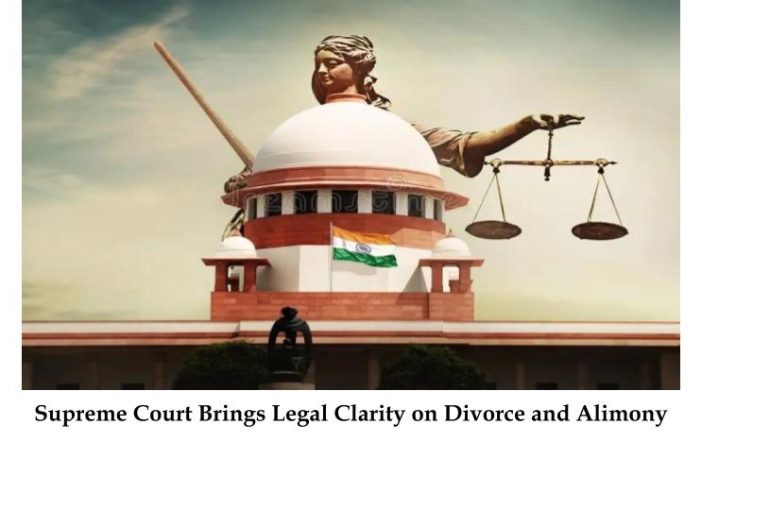Supreme Court Brings Legal Clarity on Divorce and Alimony
Introduction
The Supreme Court of India, in its judgment on February 7, 2025, in the case of Gudivada Seshagiri Rao v. Gudivada Ashalatha & Anr., 2025 INSC 195 addressed a long-standing matrimonial dispute. The case involved a couple who had spent only four months together after their marriage in 1999 but had been embroiled in multiple legal battles for over two decades. The judgment primarily revolved around issues of maintenance, divorce, and the discretionary power of the Supreme Court under Article 142 of the Indian Constitution to ensure complete justice.
Background of the Case
The Appellant (husband) and Respondent (wife) were married on May 27, 1999. Shortly after, they moved to Assam, where the husband was employed. However, their marriage quickly deteriorated, leading to separation within four months. Since their separation, the couple had been involved in continuous litigation over various issues, including maintenance and divorce. The husband claimed that the wife left him abruptly on November 1, 1999, while the wife asserted that she was unceremoniously evicted from the matrimonial home on October 31, 1999.
The key legal disputes in this case included:
- Maintenance Dispute: The wife was initially granted ₹10,000 per month as maintenance by the trial court, which the High Court later enhanced to ₹15,000 per month.
- Divorce Proceedings: The husband sought divorce on the grounds of desertion and cruelty. However, the trial court dismissed his plea.
- Legal Classification of the Marriage: The trial court mistakenly treated the marriage as one performed under Christian customs, thereby rejecting the applicability of the Hindu Marriage Act, 1955.
High Court’s Observations and Decision
The High Court examined two crucial issues:
- Whether the trial court erred in considering only desertion as a ground for divorce while ignoring the claim of cruelty.
- Whether the trial court misdirected itself by classifying the marriage as one performed under Christian rites rather than Hindu customs.
The High Court found that the trial court had failed to consider vital evidence such as caste certificates and documents proving the Hindu identity of the Appellant. Moreover, the Court emphasized that failure to establish desertion did not negate the possibility of proving cruelty. Consequently, the High Court remanded the case for reconsideration.
Supreme Court’s Observations
Upon appeal, the Supreme Court took into account the prolonged separation and irretrievable breakdown of the marriage. The Court exercised its extraordinary jurisdiction under Article 142 of the Indian Constitution to ensure complete justice. The significant observations made by the Court included:
- Recognition of Irretrievable Breakdown of Marriage: The Court acknowledged that, given the 26-year-long separation, reconciliation was impossible, making divorce the only viable solution.
- Impact on Both Parties: The Court noted that continuous litigation had inflicted emotional distress on both parties, underscoring the need for finality in matrimonial disputes.
- Financial Considerations: Recognizing that the wife, though well-educated, was unemployed, the Court deemed it necessary to provide her with adequate financial support.
Final Verdict and Directions
- The Supreme Court granted divorce on the ground of irretrievable breakdown of marriage.
- The Appellant (husband) was directed to pay ₹25,00,000 as a one-time settlement to the Respondent (wife) within six months.
- The additional ₹2,00,000 deposited earlier by the husband was allowed to be withdrawn by the wife.
- Upon completion of the financial settlement, all pending civil and criminal proceedings relating to the marriage were to be dismissed.
- The case was scheduled for review after six months to ensure compliance with the Court’s directives.
Significance of the Judgment
- Broadening the Scope of Article 142: The Court reinforced its authority to dissolve marriages even when mutual consent was absent, thereby strengthening the legal framework for resolving matrimonial disputes.
- Acknowledging the Futility of Prolonged Litigation: The ruling emphasized that extended legal battles serve no meaningful purpose and only exacerbate the suffering of the parties involved.
- Ensuring Financial Security for the Spouse: By awarding substantial alimony, the Court ensured that the financially disadvantaged spouse was not left in distress.
Conclusion
The Supreme Court’s decision sets a vital precedent for cases where irretrievable breakdown of marriage is evident. The judgment highlights the judiciary’s proactive role in preventing unnecessary prolongation of disputes while ensuring justice for both parties. By invoking Article 142, the Court not only provided a fair resolution but also reaffirmed the importance of judicial discretion in cases of matrimonial discord.
Shikha Pandey
Associate
The Indian Lawyer & Allied Services
Please log on to our YouTube channel, The Indian Lawyer Legal Tips, to learn about various aspects of the law. Our latest video, titled; “Legal Framework For Artificial Intelligence” can be viewed at the link below:





































Leave a Reply